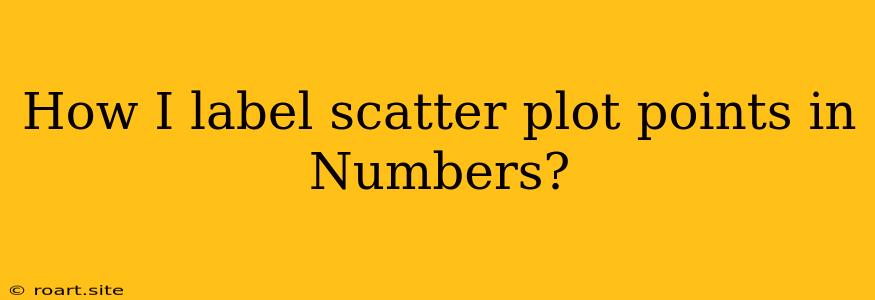Scatter plots are a powerful tool for visualizing relationships between two variables. They can help you identify trends, outliers, and clusters in your data. One way to enhance your scatter plot's clarity and insightfulness is by labeling individual data points. This allows viewers to easily identify specific data points and their corresponding values. In this article, we will explore how to label scatter plot points effectively within Apple's Numbers application.
Labeling Scatter Plot Points in Numbers
Numbers offers a straightforward approach to labeling scatter plot points. While it doesn't have a dedicated "label" function like some other software, you can achieve the same result by strategically utilizing its existing features. Here's a step-by-step guide to help you effectively label your data points:
1. Prepare Your Data
Before you start, ensure that your data is organized in a way that Numbers can readily recognize. This typically means arranging your data in a table, with each column representing a variable. The first column will usually be the variable plotted on the X-axis (horizontal), and the second column will be the variable plotted on the Y-axis (vertical).
2. Create the Scatter Plot
Open Numbers and select the table containing your data. Go to the "Chart" tab and click on "Scatter". This will automatically create a basic scatter plot based on your data. If you want to fine-tune the appearance of your plot, you can adjust the chart type, color scheme, and other visual elements using the options available in the "Chart" tab.
3. Add Labels
To label your data points, follow these steps:
- Add a Third Column: Add a new column to your data table. This column will hold the labels for each data point. In this column, enter the text you want to use as labels for each corresponding data point.
- Create a Text Chart: With the new column selected, go back to the "Chart" tab and click on "Text". This will create a text chart based on the labels in your new column.
- Combine Charts: Drag the text chart onto your scatter plot. Numbers will automatically combine the two charts, allowing you to display your labels alongside your data points.
4. Adjust Label Position and Appearance
Once you have combined the charts, you can adjust the position and appearance of your labels. You can drag the individual labels around to position them near their corresponding data points. You can also change the font size, color, and style of the labels using the options available in the "Format" tab.
5. Tips for Effective Labeling
To ensure your labels effectively enhance your scatter plot, consider these tips:
- Clarity: Use clear and concise labels that accurately represent the data points.
- Brevity: Keep labels brief to avoid cluttering the plot.
- Consistency: Use the same font size, color, and style for all labels to maintain visual harmony.
- Placement: Position labels strategically to avoid overlapping data points or other chart elements.
- Visualization: If you have a large number of data points, consider using a smaller font size or a different labeling approach to avoid overcrowding the plot.
Additional Methods
While the method described above is a common way to label scatter plot points in Numbers, alternative approaches are available:
- Data Points as Labels: You can directly use the values from your data table as labels for each point. To do this, go to the "Data" tab and choose "Show Data Points as Labels". This option automatically displays the values of each data point on the plot.
- Customizing Label Placement: You can manually adjust the position of labels using the "Format" tab. You can use this option to fine-tune the placement of labels, especially when you have a large number of data points.
- Third-Party Tools: If you need more advanced labeling features, you can consider using third-party tools or extensions that integrate with Numbers.
Conclusion
Labeling scatter plot points in Numbers is a valuable technique for improving the clarity and interpretability of your visualizations. By strategically using Numbers' built-in features and incorporating best practices for effective labeling, you can create scatter plots that effectively convey your data insights to your audience. Remember, clearly labeled scatter plots can help your data tell its own story and make a lasting impression.
